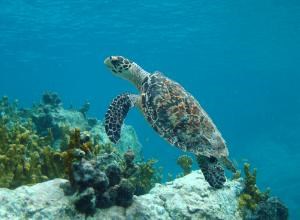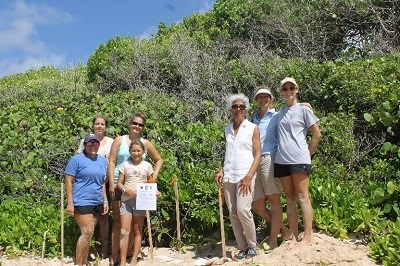Last updated: September 20, 2018
Article
VIIS Turtle Monitoring Report 2017
By Adren Anderson, Turtle Monitoring Coordinator.

Adrren Anderson
St. John sea turtle monitoring and protection program 2017 season
The St. John Sea Turtle Monitoring and Protection Program, funded by the Friends of the Virgin Islands National Park, wrapped up the 2017 season with great success. The project’s aim was to conduct island-wide nesting surveys and foster awareness for sea turtle conservation. Although the monitoring season was cut short by two category 5 hurricanes, it proved to be very successful. During a few months, the program was pleased to introduce new nest protection measurements, maintain and grow a devoted volunteer base, participate in multiple education outreach opportunities, and make an exciting discovery.
Which turtles call St. John home?
Sea turtles have been swimming the world’s oceans for over 200 million years. Today, there are seven recognized species of sea turtles; all of which are threatened, endangered, or critically endangered by national (Endangered Species Act) and international (International Union for the Conservation of Nature) classifications. Three of the seven species can be seen in the waters around the U.S. Virgin Islands: hawksbills, greens, and leatherbacks.

Caroline Rogers
Hawksbill (Eretmochelys imbricata)
Hawksbill sea turtles contribute the majority of our nests on St. John. While these turtles nest year-round, the peak of the nesting season is from August to November in the Virgin Islands. During this time, these turtles will return to their natal beaches and deposit between 3-5 nests at 14 day intervals. Each nest contains around 100-200 ping-pong shaped eggs that incubate for around 55-75 days.
This is the smallest of our sea turtles in the USVI; reaching between 24-35 inches and averaging 100-150 pounds. This turtle gets its name from the narrow and pointed beak that resembles a hawk’s bill. This turtle is found near reefs, feeding predominantly on sponges.
Hawksbill sea turtles are internationally listed as Critically Endangered and nationally listed as Endangered, mostly due to human induced threats. Aside from the common threats of all sea turtles, global hawksbill populations have been severely reduced due to overharvest for their desirable shells.

Green (Chelonia mydas)
Green turtles are commonly found along the shores of St. John foraging on sea grasses. These turtles are the largest of the hard-shelled turtles found in the USVI. The average length of an adult is around 40 inches and can weigh somewhere between 200-500 pounds. Due to a diet of sea grasses, this turtle gets its name from the greenish color of their fat.
Green turtles are internationally listed as Endangered, and nationally listed as Threatened. These turtles are commonly poached for their meat and eggs.

Leatherback (Dermochelys coriacea)
Leatherback sea turtles are the largest of all turtles. Adults can exceed 9 feet in length and weigh more than 2000 pounds. These turtles are roughly the size of a Volkswagen Beetle! They feed primarily on jellyfish, and will often mistakenly ingest plastic debris floating in the water. Leatherbacks, unlike other sea turtles, do not have a hard shell--hence the name. This flexible carapace gives them the ability to dive to depths greater than 3900 feet.
Although these turtles spend the majority of their time in the open water, leatherbacks have been known to nest on St. John. Trunk Bay was named after the large ‘trunk-like’ turtles using the area as a nesting ground.
Nationally listed as Endangered, and internationally ranked Critically Endangered, these turtles face a variety of threats ranging from entanglement in fishing gear to the harvest of eggs.

Beach Monitoring
Regular beach monitoring for sea turtle nesting activity was conducted by 39 trained volunteers from August 1-September 3. Forty beaches were monitored between 1 and 7 days a week. Beaches with higher historical nesting activities were monitored more frequently than beaches with no known activity. Beach patrols were conducted during the early hours of the morning and consisted of walking the length of the assigned beach looking for signs of sea turtle crawls, nest depredations, emergences, stranded turtles and unusual activity. Due to the abrupt end of the monitoring season, volunteer hours as well as survey efforts were inconclusive, as most data sheets were lost to hurricanes Irma and Maria.
During the monitoring season, 2 green and 2 hawksbill nests were located on Western Reef Bay. One nest was known to emerge before the storms and was excavated to determine the hatch and emergence success. The hatch success of the nest—the percentage of eggs that hatched—was 81.81 percent. The emergence success—the percentage of hatchlings that emerged from the cavity—was 79.02 percent. Two live hatchlings were found in the cavity and were released upon discovery. The status of the remaining nests after the storms is unknown. After the storms, two additional hawksbill nests were located on Windswept Beach, but were wiped out by the swell from winter storm Riley.
All of the known nests were screened against predators using a 36” x 36” metal screen with 2” x 4” openings. These screens deter predators from digging in to the nest, but allow hatchlings to escape through the openings. Zero nest depredations were recorded during the monitoring season.
Volunteer Programs
Aside from morning beach monitoring, volunteers were able to attend a variety of events to gain exposure to sea turtle conservation. A night watch program was held on two consecutive nights that had a high probability of nesting activity. Dedicated volunteers patrolled the beach every 45 minutes from sunset to sunrise in hopes of finding a nesting turtle. Unfortunately, no turtles were observed. Volunteers also had opportunities to assist in screening and excavating nests. In addition, monthly potluck meetings were scheduled to promote coordination and cooperation amongst volunteers. All events were well attended and a reliable and involved volunteer group was fostered throughout the short-lived season.

Education Outreach
Education outreach was a top priority for the 2017 season. Between June and September, 13 programs were presented to over 196 people of ages ranging from 7 to 65 years old. These programs included talks at VIERS Summer Camps, presentations for visiting colleges, snorkel programs, training for the Youth Conservation Corps, volunteer trainings, and school visits.
To evaluate the efficacy of these outreach programs, 8 groups were given a quiz before and after the presentation. The information in the quiz was based on age and covered basic sea turtle biology and conservation. The average score before the presentation was 63 percent, and rose to 93 percent after the presentation. This effort was designed to promote sea turtle conservation and proved to be a great success.

Greens Nesting on St. John
While excavating a nest that was presumed to be a hawksbill nest, two hatchlings were found buried alive inside the cavity. Upon close inspection of the prefrontal scales on their heads and coloration of the margins of their flippers, it was found that these were indeed green sea turtles. Until this point, green sea turtles had never been documented to nest on St. John. This was an exciting discovery to learn that yet another endangered species uses the beaches of St. John as critical nesting habitat.
Conclusion
Although the 2017 was abruptly halted by 2 major hurricanes, the project was able to claim many success and build a solid framework for future seasons. Education outreach goals were far surpassed, volunteer relationships and coordination efforts were established and well maintained, nest protection measures were implemented for all known nests, and the number of volunteers and beaches monitored were the highest they have been in recent history.
Thank you!
Thank you to all of the supporters of the St. John Sea Turtle Monitoring and Protection Program funded by the Friends of the Virgin Islands National Park. Thanks to all Friends employees, NPS personnel, and to all the wonderful volunteers that made this program possible!
